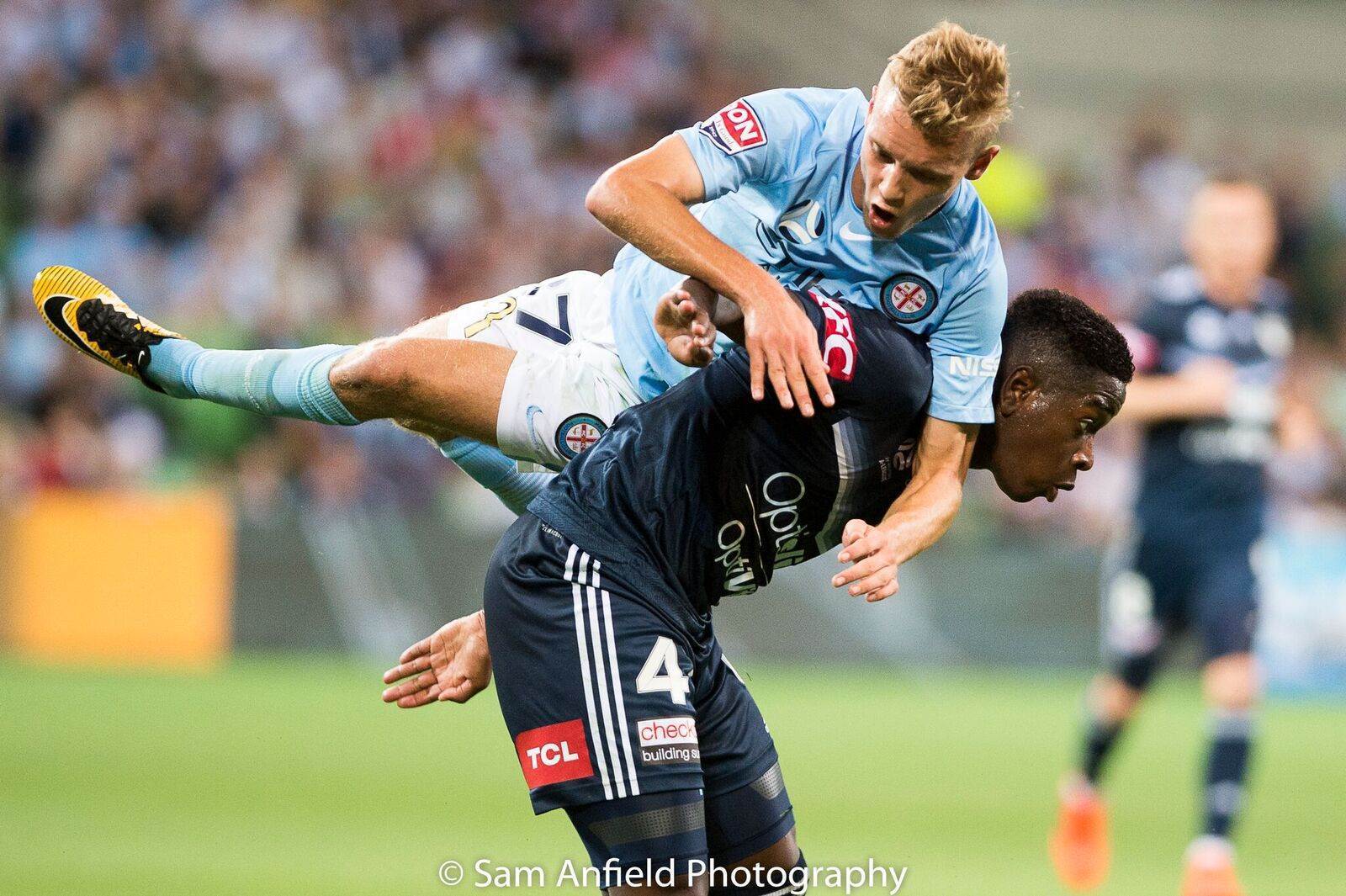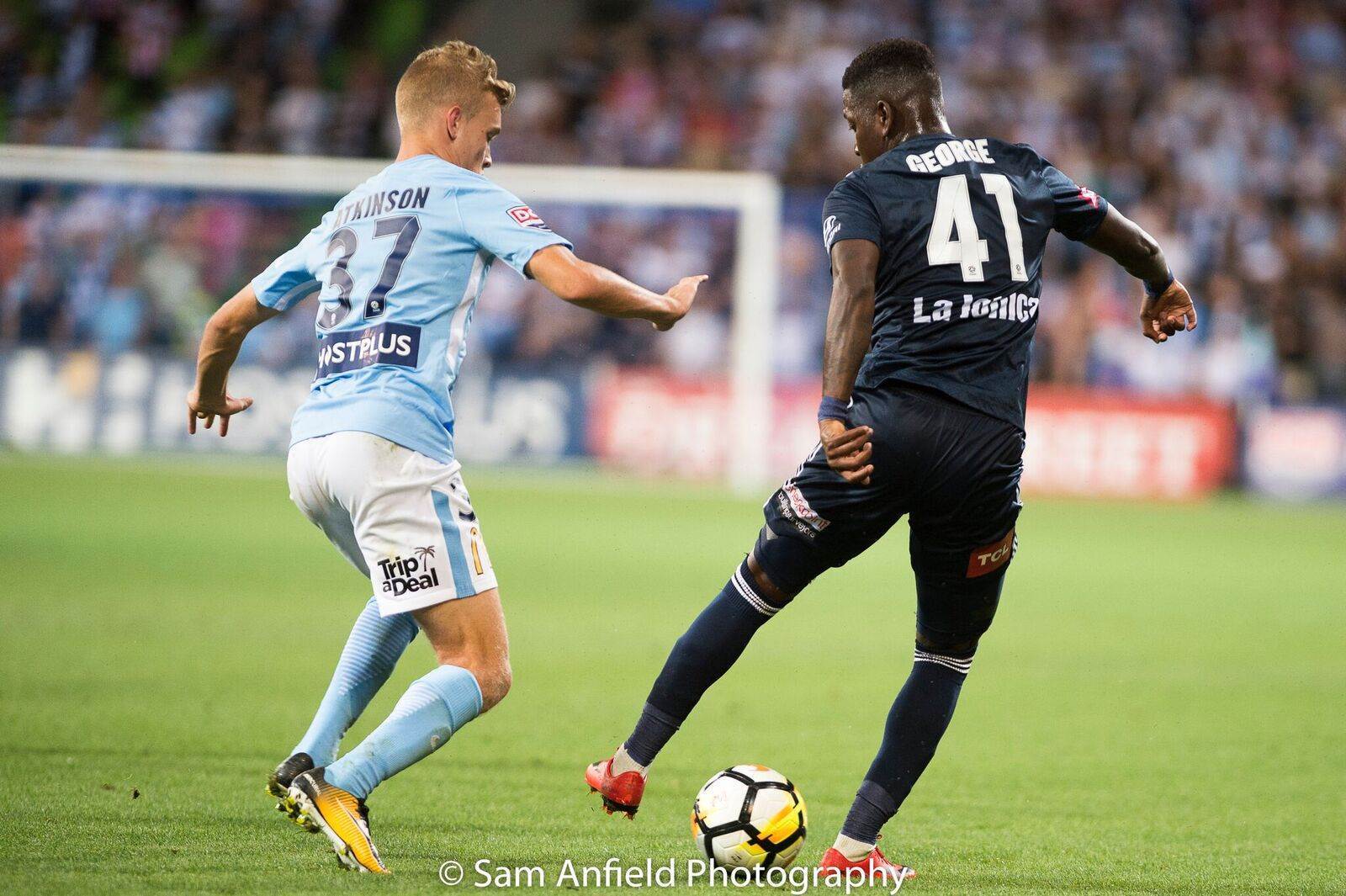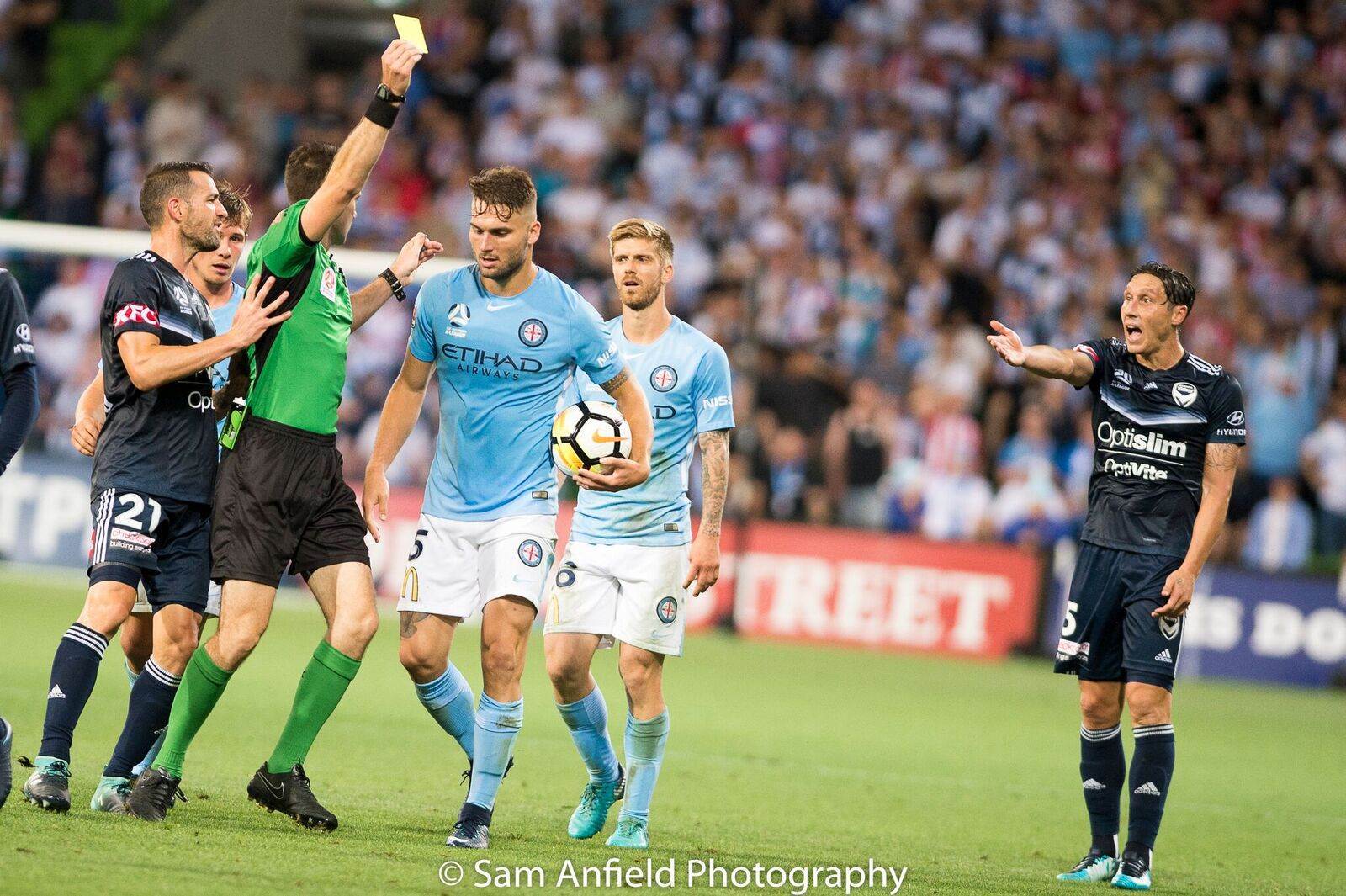In what was a finely-balanced match, the Melbourne Derby deadlock was broken deep into extra time by a trademark Mark Milligan penalty.
Melbourne City v Melbourne Victory A-League, Round 12 23.12.2017
Both sides had their opportunities, with those in navy blue benefiting from their opposition’s inability to execute a pressing strategy which has been ever-present in Warren Joyce’s debut campaign.
City without possession so far this season
Before we begin dissecting the latest derby, it is beneficial to first gain a deeper understanding of how City defend by examining past performances. In the first derby of the season, contested in early October with City winning 2-1, the front third pressing of Warren Joyce’s men resulted in a much higher degree of success.

Melbourne City’s front third pressing as seen in the first derby of the season.
Mark Milligan is a player of immense quality, and Joyce quite clearly intended on minimising his influence on proceedings as much as possible. As the match went on, Victory failed to respond, and this stifling of Victory’s build-up became a significant factor in a very solid performance from City’s perspective. As pictured above, Mauk restricted the ability of the Victory centre-backs to introduce Milligan during build-up, which had flow-on effects to the rest of the defensive system. Firstly, Ross McCormack was responsible for applying pressure on the ball carrier, with the closest winger acting as the second defender and closing down the relevant full-back. The opposite winger shifted medially to sit next to the free centre-back in order to remove the viability of a passing option. In behind Mauk, the passing line of the ball-side midfielder was cut by one of the City holding midfielders, with the other man-marking the remaining Victory player on the inside of the pitch. The closest winger is marked by the respective full-back, with the only Victory players in space being the opposite winger and to a lesser extent the opposite full-back. As a direct result of this, Muscat’s options were reduced to only a few possibilities, namely the forced funnelling of possession into wide areas or resort to direct, contested and risky passes. In that match, the penetration of Muscat’s side was severely dampened, and culminated in Melbourne City continuing their perfect start to the 2017/18 season.

We saw the adaptability of this approach in the Round 4 match against Adelaide United.
In the fourth round of the season against Adelaide, we saw the flexibility of this system as Mauk and McCormack were given very similar roles against different opposition. However, a slight change from the derby was required, as Adelaide played with two holding midfielders as opposed to the one they had experienced against Victory. This subtle difference demanded a different approach, as it was not a realistic proposition to delegate the covering of two separate players to Mauk. As a result, Mauk picked up the closest holding midfielder to the ball, with McCormack angling his run in a manner which cut the passing line to the other deep midfielder. This cooperation limited access to the holding midfielders substantially, but allowed for clear passing lines between the centre-backs. This generally wasn’t an issue, but sometimes resulted in one of the holding midfielders getting on the ball if Mauk had not been able to transition across in time. In most cases however, this did not occur and play was progressed through the wide areas.

The man-oriented defending of City as shown against Adelaide.
In the same match, we also saw further evidence of City perhaps taking a more man-oriented approach when without the ball in relation to other A-League teams. This element was still mixed with zonal responsibility, where an individual will man-mark his opposite number whilst he is in his zone of control. This extended to the covering of runs by midfielders until the movement coincided with the space of a member of the back four. In the image above, it can be seen that every City player has a clear role – one is pressing the player on the ball, one covering a run, one marking and cutting the line of an opposing player, and the other staying in close proximity to the player in his zone of control. In this match, the long debated merits of man-orientation were evident to see, as Adelaide struggled to engage in any build-up play in central areas, failing to find midfielders with any regularity. This meant that they were largely confined to wide areas, where the threat they posed was minimal. Adelaide didn’t seem to have an answer to this problem, despite the tactical limitations which exist in man-marking approaches. Joyce’s men have defended with solidity on many occasions this season, and the blocking of a central player combined with man-orientations ahead of the play are key factors in the approach of his team.
The 25th Melbourne Derby
Now that the context has been established, we can see more meaning in what Muscat and his players were able to achieve in their 1-0 win. From the outset however, it must be made abundantly clear that City’s injuries to key players meant that the personnel within the system were far from ideal. This was particularly evident with Stefan Mauk taking Ross McCormack’s role at the point of attack instead of his preferred attacking midfield position, in which Luke Brattan was located. Another key change from the October derby was the reorganising of Victory’s shape to include two holding midfielders as opposed to the single pivot which they started the season with. This presented a similar situation to the one which occurred against Adelaide, except that now City didn’t have access to their preferred players. The equation was simple – Mauk wasn’t able to perform the role in the same fashion as McCormack, and Brattan wasn’t able to function as effectively as Mauk. Combine this with poor execution of man-marking behind these players, and City were not the defensive beast that they have the potential to be.

Mauk often blocked already covered lines, and La Rocca allowed his mark to drop off into space untracked.
Mauk did not display the same understanding he showed towards McCormack with Brattan, and this often led to the stand-in striker blocking passing lines which were already covered. This left the marking and limitation of access to Sanchez solely to La Rocca, who allowed his man to drop off into space in order to receive the ball. The wide players were generally occupied by the City wingers, however Muscat’s side enjoyed far more opportunity to build up centrally than expected. This was due to the positioning of the two deeper midfielders, with Valeri taking Brattan away from the ball in order to isolate Sanchez and La Rocca in a 1v1 situation. La Rocca was provided with a complex problem; he either followed Sanchez and left too much space between the midfield and defensive lines, or he held his position and allowed Sanchez to receive the ball free of pressure. The rotations employed by Victory in the first half created many more opportunities to build-up centrally in central areas, which eventually led to a number of crossing opportunities in the final third.

Victory were able to exploit the man-orientations of City to get Troisi on the ball.
In the second half, City were defending noticeably tighter to the man, and aside from the movement of Mauk appeared much closer to achieving the solidity they have previously demonstrated this season. However, Muscat’s side were able to exploit their man-oriented approach by the lateral movement of the two deeper midfielders, which in turn opened a passing line to the creative James Troisi. This pattern of play exposes the liabilities inherent within a man-oriented approach, which is prone to destabilising movements of the opposition, in turn creating an unbalanced shape. This was indeed the case in this example, with Troisi receiving the ball in central areas many times throughout the match. Although the only goal of the match may have been the result of a bizarre foul in the box, Victory were able to create their fair share of chances using this method of build-up – a stark contrast from their last match against their City rivals.
Conclusion
Victory took the spoils in what was a much-improved performance from Kevin Muscat’s men compared to the last match against their Melbourne rivals. After a rough start to the season, three wins in the last four games has seen Victory rocket up the table, easing the pressure on their head coach in the process. A smart performance combined with a change in shape ensured that they were able to take advantage of the perceived weaknesses of their opponents, who were unable to adjust to the new situations that occurred during the match. To the victor goes the spoils, and those in navy blue will be thanking their team for an early Christmas gift.
Nathan Muir is an Australian tactical analyst and coach. You can find him on Facebook at Nathan Muir Football or on Twitter @NathanKMuir.
Related Articles

Victory's Machach wants to make amends in decider

Leckie seals new marquee deal as Good, Maclaren head to Asia
.jpeg&h=172&w=306&c=1&s=1)




























